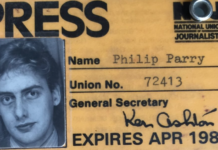- Adventure - 24th December 2025
- Crime pays but shouldn’t, part three - 23rd December 2025
- Crime pays but shouldn’t, part two - 22nd December 2025
The only problem: It wasn’t true.
The precise origins of the rumor are difficult to pin down, but it had been ricocheting around social media for days before Markey’s interview. The story had no reliable sourcing, and not a single credible news outlet touched it—but it had been fervently championed by The Palmer Report, a liberal blog known for peddling conspiracy theories, and by anti-Trump Twitter crusaders like Louise Mensch. Soon enough, prominent people with blue checkmarks by their names were amplifying it with “Big if true”-type Tweets. And by May 11, the story had migrated from the bowels of the internet to the mouth of a United States senator.
After Markey’s office apologized for spreading the unsubstantiated story, there was a mild flurry of articles warning of “fake news” aimed at the left, and then everyone moved on. But the episode jarringly illustrated an under-examined phenomenon in American politics.
But 2017 poses the question: Could the same thing happen on the left?
It’s a prospect that deserves more serious attention and debate than it’s gotten this year. The Trump era has given rise to a vast alternative left-wing media infrastructure that operates largely out of the view of casual news consumers, but commands a massive audience and growing influence in liberal America. There are polemical podcasters and partisan click farms; wild-eyed conspiracists and cynical fabulists. Some traffic heavily in rumor and wage campaigns of misinformation; others are merely aggregators and commentators who have carved out a corner of the web for themselves. But taken together, they form a media universe where partisan hysteria is too easily stoked, and fake news can travel at the speed of light.
Before we go on, let me try to quiet the cries of “False equivalence!” before they begin: No, these personalities and publications do not yet wield the same influence in the Democratic Party that their counterparts do in the GOP. But ignoring them would be a mistake. In recent months, some of the most irresponsible actors in this world have proven alarmingly adept at influencing venerated figures of the left—from public intellectuals, to world-famous celebrities, to elected officials.
Twitter conspiracists
In past political epochs, popular conspiracy theories spread via pamphlets left on windshields, or chain emails forwarded thousands of times. These days, the tinfoil-hat crowd gathers on Twitter.
People like Mensch, Claude Taylor, Andrea Chalupa, Eric Garland, and Leah McElrath feed their followers a steady diet of highly provocative speculation, rumor, and innuendo that makes it sound as if Trump’s presidency—and, really, the entire Republican Party—is perpetually on the verge of a spectacular meltdown.
The most prolific of the conspiracy-mongers tend to focus on the Russia scandal, weaving a narrative so sensationalistic and complex that it could pass for a Netflix political drama. Theirs is a world where it is acceptable to allege that hundreds of American politicians, journalists, and government officials are actually secret Russian agents; that Andrew Breitbart was murdered by Vladimir Putin; that the Kremlin has “kompromat” on everyone, and oh-by-the-way a presidency-ending sex tape is going to drop any day now.
Writing recently in The New Republic, Sarah Jones identified the popularity of these notorious tweetstormers—some of whom boast followings in the hundreds of thousands—as part of a “disturbing emerging trend” on the left. “Liberals desperate to believe that the right conspiracy will take down Donald Trump promote their own purveyors of fake news,” she wrote.
Hyperpartisan Facebook pages
If Twitter is where liberal conspiracy theories germinate and spread among news junkies, Facebook is where anti-Republican propaganda can go wide.
An analysis by BuzzFeed during the frenzied final weeks of the 2016 election found that nearly 20 percent of the stories posted by three extremely popular liberal Facebook pages—Occupy Democrats, The Other 98%, and Addicting Info—were either partly or mostly false. While conservative Facebook pages were even more likely to spread false stories, BuzzFeed’s finding should serve as a red flag for the kind of the news that millions of rank-and-file Democrats are getting on the world’s largest social-media platform.
Blogs and message boards
The roots of the liberal blogosphere can be traced back to the early Bush years, when Markos Moulistas launched the Daily Kos to crusade against “an oppressive and war-crazed administration” and Josh Marshall used Talking Points Memo to take the Senate Majority Leader to task. A decade and a half later, some of the blogs of that era have matured into more professional news sites, like TPM, while others have disappeared. But in 2017, the left has more niche political sites than ever, and in many ways they make up the core of its modern media ecosystem.
Meanwhile, old-school platforms like Reddit and Daily Kos continue to host freewheeling forums that attract the kind of occasionally enlightening, occasionally deranged conversations that tend to thrive in those environments. And the HuffPost contributor platform—an un-vetted, unedited section of the site that operates apart from its professional journalism—has been a vehicle for some of the most bizarre, and outright craziest, content to go viral on the left in recent years.
Just this month, editors were forced to delete a contributor post that began, “Impeachment and removal from office are only the first steps; for America to be redeemed, Donald Trump must be prosecuted for treason and — if convicted in a court of law — executed.” And throughout last year’s primaries, Seth Abramson, a creative writing professor at the University of New Hampshire, used his HuffPost perch to churn out a procession of increasingly delusional blog posts explaining why Bernie Sanders would inevitably win the Democratic nomination.
Abramson’s arguments not only denied political realities and delegate math as the race wore on; they often denied basic human logic. But thanks to the hordes of Bernie fans desperately scouring the internet for some hope to cling to, Abramson’s posts consistently went uber-viral. (He eventually wrote a post defending this shameless play for clicks as a form of “experimental journalism” that embraced “the multi-dimensionality of metanarrative.” The Washington Post’s Matt O’Brien responded via Twitter: “Area Academic Writes Barely Comprehensible Defense of Lying.”) These days, Abramson’s main platform is Twitter, where he has over 150,000 followers, and specializes in imminent-indictment stories in the style of criminal complaints.
Podcasts
The constellation of popular podcasts that has emerged on the left serves many of the same functions that right-wing talk-radio hosts served for their audiences in their early days. They provide a mix of commentary, entertainment, and partisan catharsis; a safe space to process the daily onslaught of bad news.
The hosts tend not to be household names, but to their listeners they are superstars. The most successful podcasters—from the mainstream Democrats of the Crooked Media empire, to the gleefully vulgar champions of the “dirtbag left” at Chapo Trap House—are able to sell out theaters for live shows, and can even get recognized on the street (in certain zip codes, at least).
The nature of the medium—walled off from the web and unplugged from social media—means that podcasts are not innately integral to the spread of sketchy information on the left. Above all, they offer their stressed-out listeners a sense of community (plus plenty of discount codes for Blue Apron and MeUndies).
VIP Validators
One sign of the potential power in this alternative media universe is the regularity with which stories that originate there end up reaching public figures with real influence and massive followings. These may be people who are relatively unsophisticated when it comes to politics and media, but whose prominence in other fields—academia, history, law, literature—gives them a certain sheen of trustworthiness. So when they share stories from fringe outlets on Twitter or Facebook, many are inclined to take them seriously.
Last April, when Jason Chaffetz announced he would resign his House seat, The Palmer Report published an anonymously sourced bombshell claiming the FBI had discovered the Utah congressman was being blackmailed by the Kremlin. The story was characteristic of the site’s well-worn shtick. But that didn’t stop Ned Price, a former special assistant to President Obama, from credulously passing it along on Twitter.
“Interesting, if single-sourced, article from a few days ago,” he wrote.
Eric Schultz, a senior adviser to Obama, then chimed in, “Too bad nobody flagged this earlier.”
When journalists began pressing the duo on why they were sharing a story from a website with such a spotty track record of accuracy, Price’s response was telling. “Every once in a blue moon, the tin hat can fit.”










